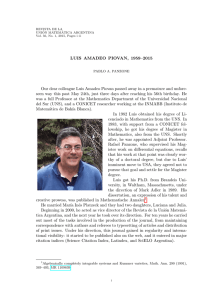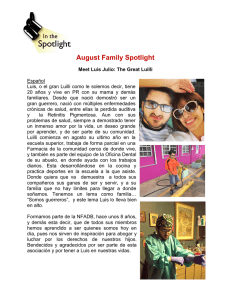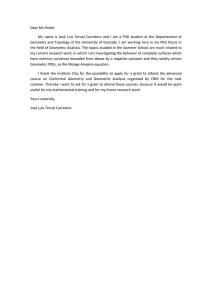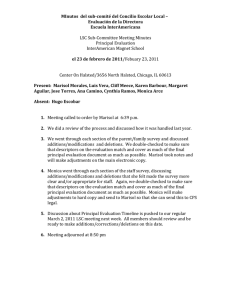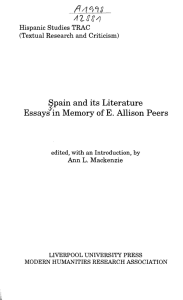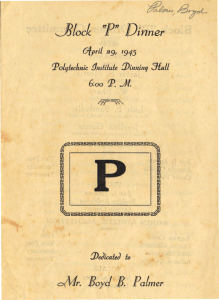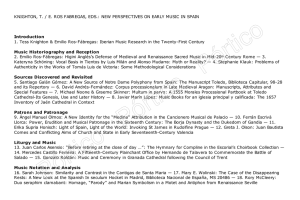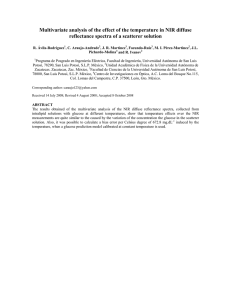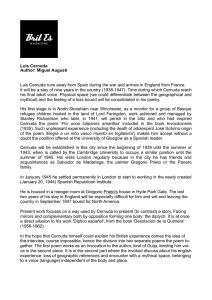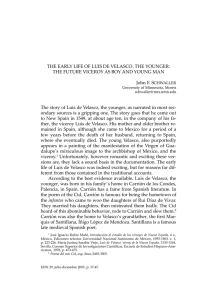Luis García Ballester: Personal recollections
Anuncio
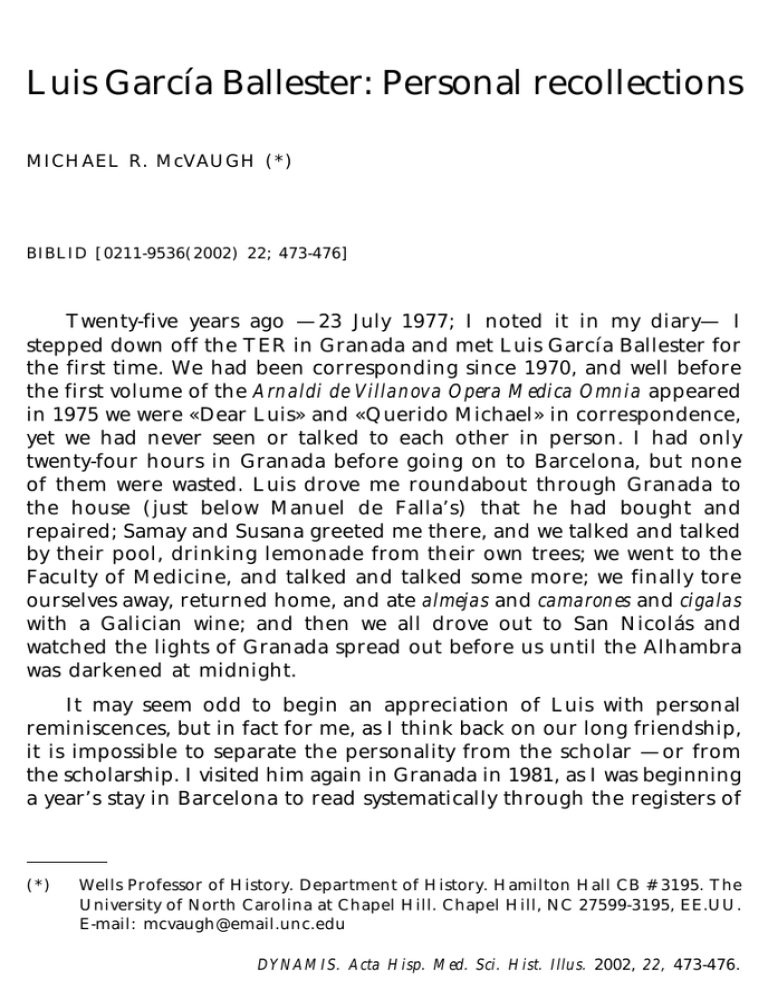
Luis García Ballester: Personal recollections MICHAEL R. McVAUGH (*) BIBLID [0211-9536(2002) 22; 473-476] Twenty-five years ago —23 July 1977; I noted it in my diary— I stepped down off the TER in Granada and met Luis García Ballester for the first time. We had been corresponding since 1970, and well before the first volume of the Arnaldi de Villanova Opera Medica Omnia appeared in 1975 we were «Dear Luis» and «Querido Michael» in correspondence, yet we had never seen or talked to each other in person. I had only twenty-four hours in Granada before going on to Barcelona, but none of them were wasted. Luis drove me roundabout through Granada to the house (just below Manuel de Falla’s) that he had bought and repaired; Samay and Susana greeted me there, and we talked and talked by their pool, drinking lemonade from their own trees; we went to the Faculty of Medicine, and talked and talked some more; we finally tore ourselves away, returned home, and ate almejas and camarones and cigalas with a Galician wine; and then we all drove out to San Nicolás and watched the lights of Granada spread out before us until the Alhambra was darkened at midnight. It may seem odd to begin an appreciation of Luis with personal reminiscences, but in fact for me, as I think back on our long friendship, it is impossible to separate the personality from the scholar —or from the scholarship. I visited him again in Granada in 1981, as I was beginning a year’s stay in Barcelona to read systematically through the registers of (*) Wells Professor of History. Department of History. Hamilton Hall CB # 3195. The University of North Carolina at Chapel Hill. Chapel Hill, NC 27599-3195, EE.UU. E-mail: [email protected] DYNAMIS. Acta Hisp. Med. Sci. Hist. Illus. 2002, 22, 473-476. 474 IN MEMORIAM the Archivo de la Corona de Aragón, in an attempt to understand from primary documentation the character of early fourteenth-century medicine there; again Luis welcomed me warmly, and characteristically shared with me his rich bibliographical command of the historical literature of medicine in medieval Catalunya. Characteristically, too, when after that year I resolved to expand my search from Barcelonan archives to others in the Crown of Aragon, Luis used his personal contacts to make that possible for me —arranging for me to live in his own Colegio Luis Vives in the summer of 1983, while I worked in the archives of his beloved Valencia; again arranging a place for me to live in Zaragoza in the summer of 1986, and providing me an entrée into the university world there. But by this time the project was as much his as mine —it was hard to remember a time when we had not been talking about it together, and we began to plan a social history of Catalan medicine for the whole of the fourteenth. Over the next five years we worked our way through a dozen archival collections, «hoja a hoja», as we used to tell ourselves proudly, each archive more exciting than the next: after Zaragoza, Lleida and Cervera in 1986, Girona in 1987, Manresa, Tortosa, and Vic in 1989. In the process, he introduced me to Catalunya, giving me a sense of locality. My recollections from those years, like my memory of Granada, associate him with particular contexts and events: my introduction to cecina, shaved from a leg in a dark butcher’s shop in Morella; our startled discovery of a leaden bullet still embedded in a Leridan register, making the Civil War suddenly real to me; our daily voyages to Girona from l’Escala, where a friend had loaned him a house, and which now comes back to me every time I see an anchovy. And places mattered to Luis. One summer he himself spent poring over the archives in Puigcerdà, commuting from the house he and his family had rented in Llívia, and he was deeply intrigued by the fact that he was returning every evening to a bit of Spain completely surrounded by France. Again, he was quietly delighted that the apartment he bought in carrer Notariat while he was Profesor de Investigación at the Consejo was not only conveniently across from the notarial archive, but was also actually in the same building where Ramón y Cajal had lived in Barcelona. Perhaps therefore it is right that I remember so vividly the physical setting in which we first met and the places where we worked. DYNAMIS. Acta Hisp. Med. Sci. Hist. Illus. 2002, 22, 473-476. Luis García Ballester (1936-2000) 475 It may be that Luis’s feeling for the particularity of place was a facet of one of the things that characterized him as a historian, his fascination with concrete detail and its meaning. It was a fascination that I felt, too, and on our travels home from archives we talked about the documentary discoveries of the day, not about discourse and deconstruction. Some days, of course, there would be nothing, eight hours spent going through notarial manuals with not so much as a barberius turning up in the record; other days we would exult in a series of unexpected testimonies. It was not the facts in themselves that intrigued him so much as what they might suggest for the larger fourteenth century that was emerging; his sense of significance was such that often his judgement would be later confirmed by a document that surfaced another day in another archive. It was in this way, as he and I were at work with Agustín Rubio Vela, preparing a study on medical licensing in Valencia, that Luis was able to consider isolated licenses from the 1370s and 1380s and recognize their probable evolution out of the circumstances peculiar to the kingdom and the city in the first half of the fourteenth century. Luis’s personality and his scholarship fused together in another important way as well. His transparent sincerity and his enthusiasm could charm the most cautious archivist out of his reserve, and regularly gave us access to materials that might otherwise have been difficult or impossible to consult. Local archives operated somewhat more informally in the 1980s than they do today, of course, but, even so, Luis’s candour regularly won us unusual favors. In one archive we were given the run of a vast storeroom to look for missing documentation; in another, we were given the key to work in the evening, told only to lock up when we left; in a third, we were given a document to study which another researcher, three months later, was assured could not possibly exist. Virtually anyone who met Luis and talked to him about his work recognized his overriding dedication to the integrity of scholarship, transcending national or local or institutional loyalties, and knew that he could be trusted absolutely. Luis’s interests were so broad and his energies so great that he did not of course limit himself to the Crown of Aragon, or indeed to the history of medicine. His work on the far more poorly documented history of science and medicine in Castile and Leon, which was an DYNAMIS. Acta Hisp. Med. Sci. Hist. Illus. 2002, 22, 473-476. 476 IN MEMORIAM important theme in the last fifteen years of his life, showed these same traits, and here, where the evidence is so scanty, they were even more critical: I am thinking particularly of his analysis of notes on a single leaf in a Vatican manuscript, which allowed him to draw astonishing conclusions about the presence of scientific interests among the mendicant communities of Santiago de Compostela already in the 1220s, to situate this peninsular interest within wider European intellectual developments, and to raise important questions about what happened subsequently to natural-scientific study in Castile. These researches, combined with the incessant labor Luis expended on AVOMO, which alone made possible the series’ survival and success, meant that the social history of later fourteenth-century Catalan medicine was temporarily set aside —none of us guessing that «temporarily» would become forever. Luis’s meticulous notes, in that familiar regular handwriting —from the registers of Joan I and Martí I, from Mallorca, from Puigcerdà, and elsewhere— may someday be used, I suppose, but not as he himself could have exploited them. Somewhere in his papers is the material for a paper he once excitedly sketched out to me, concerning Nadal Lambri, master of medicine in the medical faculty at Lleida in the 1390s, and his participation in the inquest into the mysterious death of a countess —or so I seem to remember; somewhere are his notes on dozens of apothecary inventories from all over Catalunya, which he transcribed whenever he came upon them. These are just two of the many fertile subjects for study that he was incessantly tossing off. Inexhaustible in his investigations, forever passing on brilliant and exciting insights —even in the papers he never got to write, Luis remains a model and an inspiration for us all. DYNAMIS. Acta Hisp. Med. Sci. Hist. Illus. 2002, 22, 473-476.
